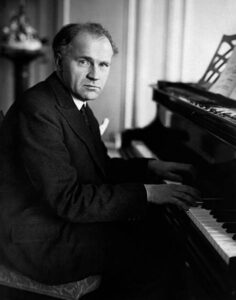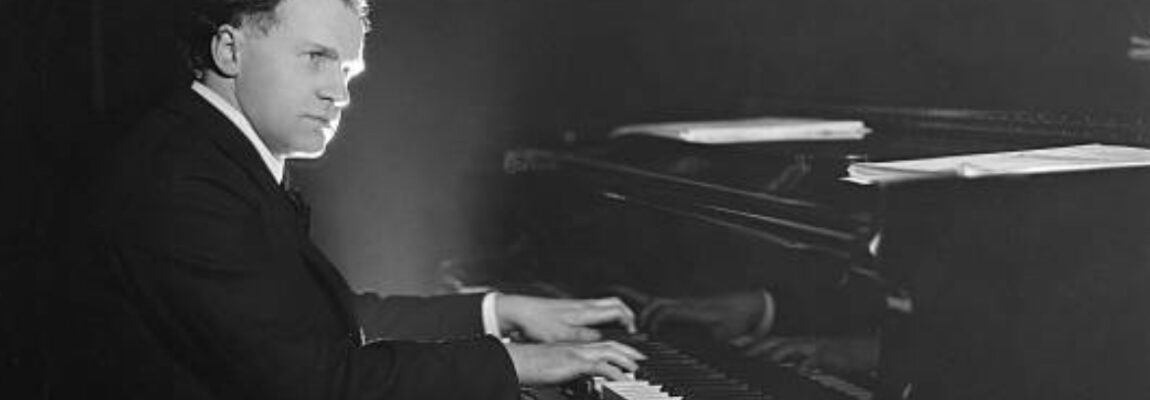German pianist Wilhelm Backhaus had one of the longest recording careers of any pianist, spanning an incredible 61 years from the first flat discs using acoustic amplification (cone-shaped horns amplifying the sound rather than microphones) to the stereo era, and these reveal an incredible evolution of style. Given that he produced so many recordings as an elderly man – and commercialization’s tendency to focus on what’s new rather than the past – it is quite amazing to experience how different his playing was in his younger years. Of course it should be obvious that he would play differently as a younger man (who wouldn’t) but there is certainly a fire, passion, and daring disposition that can be found in his earliest recordings that are less overtly evident in his later studio accounts, though there are glimmers in some live recordings.
 January 1928 saw the artist product a significant number of recordings in an astonishingly short space of time: in the space of two days on January 4 and 5, he recorded the complete Chopin Etudes Op.10 and Op.25 (the first cycle on disc) and E-Flat Waltz Op.18, the Schumann-Liszt Widmung, Smetana’s Polka No.3, Triana by Albeniz, Moszkowski’s knuckle-busting Caprice espagnole, and his own arrangements of a Mozart Serenade from Don Giovanni and Schubert’s Marche Militaire in E-Flat Major. This is a truly astonishing accomplishment at a time when no precision editing was possible and therefore entire 4-to-5-minute segments of music needed to be recorded ‘as is’ for each side of a 78rpm record!
January 1928 saw the artist product a significant number of recordings in an astonishingly short space of time: in the space of two days on January 4 and 5, he recorded the complete Chopin Etudes Op.10 and Op.25 (the first cycle on disc) and E-Flat Waltz Op.18, the Schumann-Liszt Widmung, Smetana’s Polka No.3, Triana by Albeniz, Moszkowski’s knuckle-busting Caprice espagnole, and his own arrangements of a Mozart Serenade from Don Giovanni and Schubert’s Marche Militaire in E-Flat Major. This is a truly astonishing accomplishment at a time when no precision editing was possible and therefore entire 4-to-5-minute segments of music needed to be recorded ‘as is’ for each side of a 78rpm record!
Fortunately the APR label has reissued all of these performances and many more in a highly-recommended two-disc set comprising the pianist’s 1925-1937 HMV recordings (available here). I thought it might be fascinating to explore all of the recordings that Backhaus produced on those two days of January 4 and 5, 1928 in order to better appreciate his multifaceted artistry.
Backhaus began to set down his groundbreaking first recorded cycle of Chopin’s Etudes at his January 4, 1928 session, concluding them the following day. From today’s perspective, Backhaus does not appear to be the most obvious choice for this honour, but as can be heard, his pianism was suited to a range of repertoire well beyond the German classics for which he is best remembered. He plays with an ideal fusion of technical command, emotional expressiveness, and carefree (yet never completely off-the-rails) abandon – certainly much wilder than those familiar with his more famous later readings of Beethoven might expect, but always with astounding musicality and impeccable style. Backhaus plays with both great freedom and refined nuancing, with a beautiful singing sonority (his Op.10 No.1 should be played for pianists who think that ‘fast’ means you can’t have polished tone), rhythmic bite, consistency of articulation and phrasing in virtuoso passages (which helps to highlight the architecture of the works), and mastery of the pedal, all serving to reveal the character of each work marvellously well.
At his January 4 session Backhaus recorded one Chopin work in addition to the Etudes, the first of the standard edition of 14 waltzes, the Grande valse brillante in E-Flat Major Op.18. This work too is played with a wonderful combination of clarity, poise, and elegance, with a combination of emotional expressiveness and directness.
Among the transcriptions that Backhaus recorded on January 5 is his own arrangement of Schubert’s Marche militaire in E-Flat Major D.733 No.3. Here too we hear inspired pianism, with incisive rhythm, deftly defined articulation, and gorgeous tonal colours, the dazzling runs and rapid-fire octaves despatched with incredible lightness and ease.
The Liszt transcription of Schumann’s Widmung (with some of Backhaus’s own touches) showcases the pianist’s gorgeous singing tone, soaring melodic line, marvellous pedal effects, and attentive voicing – an inspired reading with lush textures and refined nuancing.
Smetana’s Polka No.3 in F Major (from Czech Dances, Book 1) is a less-played work that receives a wonderfully vivacious reading, with beautiful tone throughout both the virtuosic and lyrical passages.
Just as present-day listeners might have been surprised to hear Backhaus playing Chopin, so too does Albeniz seem outside the repertoire we’d expect to hear him play. But what a gorgeous account of Triana he set down on his January 5 session, with beautiful tone, a lovely lilting rhythm, and clearly highlighted melodic subjects and harmonic support.
Equally unexpected is Backhaus’s high-octane reading of Moszkowski’s knuckle-busting Caprice espagnole Op.37, a more virtuosic ‘pushing the edge’ approach in some passages than one might anticipate based on his more celebrated recordings. He plays throughout with remarkably fleet fingerwork and a gorgeous rich sonority, and note how he caresses the bass notes in the middle section to provide a deep resonant undertone to the singing melodic line and its more crisply defined accompaniment. Absolutely magnificent!
I thought I would end this feature with the incredible recording Backhaus made of his own transcription of ‘Deh, vieni alla finestra’ from Mozart’s opera Don Giovanni. The performance is both charming and dazzling, with a beautifully phrased melodic line in the left hand, with gorgeous full-bodied tone, the virtuosic passages dispatched with such panache and charm, the colours and dynamic shadings truly breathtaking. This is now one of my all-time favourite recordings, one that can be heard and marvelled at over and over. A brilliant sonic document by a truly astounding pianist!
It is incredible to consider that all of the above recordings were produced in two days of sessions back in the first days of 1928 – 95 years ago! As stated, producing this volume of discs in the days before tape splicing or digital editing, when multiple complete takes were required, is a phenomenal achievement, and artistically these recordings are also absolutely extraordinary. We can be extremely grateful that APR has republished these amazing performances (and others from the early years of the pianist’s recording career) so that we can so easily appreciate the artistry of the great Wilhelm Backhaus.
